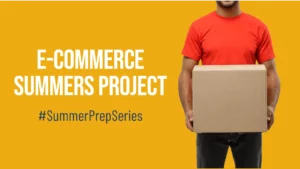
With this summer prep series, we want to help you crack a PPO in your summers. And if your summers is in E-commerce, you’re at the right place. E-commerce is only dominated by a couple of companies like Flipkart, Amazon and Snapdeal. Cracking a PPO in these companies will set you up for your career. To help you with this, we are going to decode a project to give you an idea about how to approach your summers project in E-commerce. Without further ado, let’s deep dive into the E-commerce project.
Summer Internship Project: Develop a go to market strategy for monetization of internally developed games through Quipkart’s web portal and app
Project Brief
Quipkart’s “super app” will be a one stop solution to consumers’ E-Commerce needs. It will be launched as an integrated platform to carry out a vast variety of activities such as shopping online, booking event tickets, transferring funds. In a bid to engage with consumers at all touchpoints Quipkart’s internally developed games will also be present for users on the app and website to engage with. Currently Quipkart has 3 such games running, and players can win exciting rewards such as headphones, speakers etc. by playing the games and leveling up. These rewards are primarily to increase stickiness of the games with recurring players as well as onboard new players. Quipkart believes that the games space holds monetization potential in the form of ad revenue. As per the revenue model Quipkart will lease out ad space to brands that want to advertise to Quipkart’s large game playing audience.
Objective and Deliverables
- Device a B2B marketing strategy for Quipkart to bring brands on board for the purpose of generating ad revenue through the platform of games on web and app.
- Generate consumer insights on the current players and suggest how new players can be acquired. Improve stickiness, top of mind recall, customer engagements.
- Develop a pricing strategy for games’ ad space leasing. Identify key opportunity areas for Quipkart in the gamification space.
Approach
- Study of the current landscape of E-Commerce gamification was done by analyzing competitors: Romazon and RayTM. Analysis comprised of secondary research of publicly available information as well as interviews with game players on these platforms. Experiences of those who had participated in brand sponsored quizzes on Romazon were collected.
- It was found that the space had potential to be monetized and Quipkart could win with the first mover advantage since competition was not sustainably leveraging ad revenue in games. Analysis of the games currently available of Quipkart’s platform was done and consumer behavior studied through analytics metrics such as average time spent.
- User profiles were studied across 3 lakh game players and target groups identified. A universal sample set was chosen from the internally available data on demographic and geographic details of game players and this was analyzed on excel to come up with 12 hyper-segmented groups based on age (2 groups), gender (2 groups) and type of game played (3 groups). (how to create cohorts & consumer immersions)
- Key parameters were drawn basis product and category buying behavior on Quipkart marketplace for each hyper-segmented group.
- Brands relevant to various TGs were contacted to pitch ad space leasing basis
- Ideation was done on how to incorporate brand messaging without hampering the experience of gaming. This was in collaboration with the product development team to ensure a smooth game playing experience with the advertisement not taking away from the player’s immersive game playing experience.
- After thorough discussions with multiple stakeholders such as a group of game players, internal development teams and the client customized ads for each brand were suggested and rated on a 5 point scale. A weighted average of these ratings was used to decide the final appearance of the ad within or outside the game.
- Internal and competitor pricing for banner ads across web and app were studied to create a pricing benchmark for game ads.
Stakeholders
External: Companies and brands onboarded; creative agencies; game developers
Internal: Category heads vying for visibility, finance team for pricing data, legal team for data protection compliance, product management team for tweaking app and web portal.
End Result
- 21 brands onboarded for initial partnership for games’ ad space leasing. This led to Rs. 35 Lakhs being monetized in the first phase of implementation.
- Innovating ad propositions such as in game advertising suggested in order to smoothly integrate ads in user’s gaming experience. Eg) For a quizzing game a sponsor’s question asked as part of the quiz: when will YellowMi’s next generation phone be released? Eg) Offering level ups in games or second chances once a sponsor’s page is visited by the player.
- Pricing strategy was formulated basis display ad benchmarking and adjusting after comparing views, impressions, click through rate.
- Suggested smaller rewards over a wider audience basis usage trend analysis.
- Suggested opportunities for leveraging games as an ad platform to brands: new launches, pushing slow moving products, sampling to a large and relevant audience.
Challenges
- Pricing of a large scale project in a new unexplored category was a challenge. Competitor’s had not ventured into the space and Quipkart was looking to leverage a first mover’s advantage in tapping into gaming ad revenue. There were no external benchmarks on pricing. Pricing had to be done by internally benchmarking against other ad platforms such as home page display ads.
- Building trust with brands and on boarding them to this new ad platform was challenging especially so for an intern who couldn’t formally identify as an employee of the company. Extensive pitch decks explaining the model had to be created and constant follow ups with potential clients over E-mail and phone were a regular part of the day. Demos of how their ad would appear were also required by some clients. This was done by overriding different brands on the gaming template.
- Balancing the interests of the end users: gamers as well as that of clients: brands was a trade-off. Interactions with game players through self-conducted consumer immersions helped understand their perspective. Key Account Managers were useful in building relationships with brands to meet their expectations.
End Review Questions
Project specific
- What are some key opportunity areas for Quipkart in the gamification space as well as in the super app as a whole?
- What is difference between in-game ads and other app/web based display ads?
- How did you search for brands to onboard?
- How did you balance the interest of end users and ad clients?
- Do you have any suggestions to on-board new gamers?
HR + General questions
- What was the biggest challenge while working on the project?
- What was the key take-away from the internship?
- Is there anything you wish to have done differently in the project?
- Why do you want to pursue your career with Quipkart?
- What do you feel about the new FDI E-Commerce ruling?
Now this is just one type of project you might get. Although, projects across sectors tend to have a lot in common. So make sure, you keep an eye out for other sector projects as well.
This article was written by Sneha Roy from FMS.
Check out our courses









